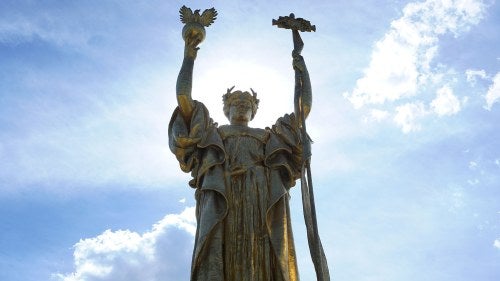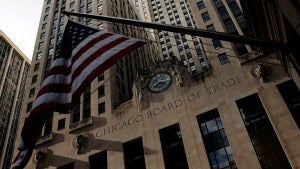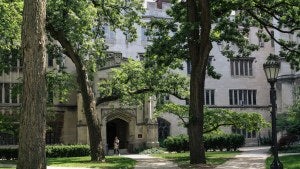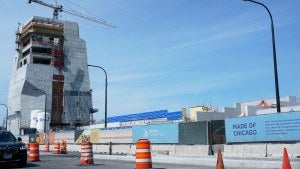Five Chicago landmarks that tell the story of the American Century

Ride along with University of Chicago professor Paul Poast as he walks us through the Chicago sites that shaped global affairs.
Far from the capital and coasts, Chicago may not seem like a hub for geopolitics. But the city is full of landmarks that shaped America’s foreign policy — as University of Chicago professor Paul Poast knows well. A few times a year, Poast leads students, tourists, and even longtime Chicago residents on a tour of five local spots that tell the history of the so-called American Century and “mark the emergence, the establishment, and the culmination of the United States as a major power on the world stage.”
It wouldn’t be the University of Chicago if it didn’t come with some assigned reading: Poast gives participants a copy of Henry Luce’s 1941 “Life” magazine article “The American Century,” which gives the tour its name.
Luce, says Poast, “was arguing that the United States needed to take up the mantle of global leadership,” and that “the United States needs to step away from its age of isolation…and embrace its role on the world stage.”
Poast, who is a non-resident fellow with the Chicago Council on Global Affairs in addition to his work in the university’s political science department, tracks 130 years of American foreign policy in his tour. Here are five spots in the city that he thinks tell the story of this American era and Chicago’s place in it.
Jackson Park — America the Great Power
In 1893, Chicago was the center of the world. That year, the city held the World’s Columbian Exposition, and the Midway and Jackson Park hosted millions of visitors from across the world touring the fair’s exhibits, bazaars, bakeries, and theaters.
“Countries used world fairs in the way that a lot of countries use the Olympic Games today,” said Poast, and the Chicago fair was an important way for the United States to show off.
The fair, according to Poast, was “an opportunity to show that the U.S. was an industrial power and was now ready to enter the world stage, as it could be considered on the same level as all the great European powers.”
Though most of the structures built for the fair were temporary, you can still see a prominent vestige of the event in Jackson Park. The 24-foot golden statue near the park’s inner harbor is a smaller replica of “The Republic,” a massive artwork that towered over the exposition’s grounds. Like the original, today’s version of the statue depicts a woman holding a globe with an eagle perched on top, and a staff emblazoned with the words “liberty.”
The symbolism is “very clear,” says Poast. The fair signaled America’s global ambitions.
Chicago Board of Trade — America the Economic Power
“If you really want to think about the sources of American power, you could do a lot worse than going to the Chicago Board of Trade,” said Poast.
Established in 1848, the Chicago Board of Trade originally helped farmers and their customers manage risky prices for agricultural products, livestock, and commodities. Chicago was the perfect spot for such an exchange, because it was in America’s agricultural heartland and right at the center of the nation’s growing railroad network.

The Chicago Board of Trade building
During World War I, the Chicago Board of Trade was an essential piece of financial and logistical machinery for European nations trying to feed their citizens and soldiers.
“They’re buying this on the Chicago Board of Trade, and they’re all competing with each other,” said Poast, who is co-writing a book on the trade, “Empowering the Problem Solvers.”
Today, the exchange on West Jackson Boulevard is known at least as much for its National Historic Landmark building as for the work done inside. But still, visiting the structure (which was once the city’s tallest) “captures not just the centrality of Chicago, but really the U.S.’s great geographic advantage,” said Poast. “Both the fact that it is this power that has two oceans on either side, but also the nature of the plains itself: the fact that it can produce food.”
Regenstein Library — America the Superpower
The tour’s next stop is the “Nuclear Energy” sculpture outside the Regenstein Library, which commemorates the first sustained nuclear reaction, pioneered at the University of Chicago on December 2, 1942. Shaped like a human skull and a mushroom cloud, the piece shows “a contained power and force” fitting its subject, according to the artists.

The “Nuclear Energy” sculpture
The experiment in Chicago only generated enough energy to turn on a small lightbulb, but it propelled the Manhattan Project forward as it raced to build a nuclear bomb.
The atomic bomb led to the end of World War II and ushered in a nuclear age of deterrence and mutually assured destruction between two global rivals. The World’s Fair marked America’s rise to become one of many global powers, but the atomic bomb established the U.S. — and then the Soviet Union — as superpowers.
Social Science Research Building Room 122 — America the Hegemon
The tour then winds across the university’s main quad to the Social Science Research Building’s Room 122. In 1989, Francis Fukuyama told a lecture hall full of faculty and students here that the Cold War was about to end.
His address, “The End of History?,” asked if the end of the Cold War would establish Western liberal democracy as the unambiguously superior societal model, rendering debates over governance obsolete. Later that year, the Berlin Wall fell, and in 1992 Fukuyama published “The End of History and the Last Man” — without the question mark.

University of Chicago Campus, Social Science Research Building

Room 122 lecture hall
“This was a very provocative address,” said Poast. Fukuyama was arguing that “liberal democracy and capitalism would be the dominant mode of political and economic governance around the world,” he explained.
“It also starts to become this notion, especially in D.C., kind of informing the view of the era that we’re in,” Poast said. In the wake of Fukuyama’s lecture and book, the idea that U.S. political and economic systems were the best in the world began to inform how policymakers saw the country and themselves.
Obama Presidential Center — American Competition
The tour usually ends there, but Poast says that, if he were to add a stop for the 21st century, it’d be the still-under-construction Obama Presidential Center.

Ongoing construction of the Obama Presidential Center
“Some would argue that the unipolar moment,” or the period of unrivaled American power, “ended during the Obama administration — not because of anything Obama did, but because Obama was president during a time of great change in a global system,” said Poast.
He cites the rise of China, heralded by the 2008 Olympics, as an example of the reemergence of the kind of great power competition America entered into when it marked the dawn of the American century with the Chicago world’s fair. Poast also points to 2013 comments from Obama’s then-Secretary of State John Kerry, who said, “We live in a world more like the 18th and 19th centuries” — one with several competing powers, not just one or two global superpowers.
“If the American century was this gradual rise from the 1890s to the 1990s, [with] the U.S. becoming the dominant global power,” said Poast, “by the time you get to the Obama presidency, you're already seeing a return to multipolarity and a very different international system.”
This story first appeared in the ChicagoGlobal newsletter, a joint project of Crain's Chicago Business and the Chicago Council on Global Affairs.

